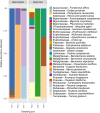Unraveling the plant diversity of the Amazonian canga through DNA barcoding
- PMID: 34646474
- PMCID: PMC8495817
- DOI: 10.1002/ece3.8057
Unraveling the plant diversity of the Amazonian canga through DNA barcoding
Abstract
The canga of the Serra dos Carajás, in Eastern Amazon, is home to a unique open plant community, harboring several endemic and rare species. Although a complete flora survey has been recently published, scarce to no genetic information is available for most plant species of the ironstone outcrops of the Serra dos Carajás. In this scenario, DNA barcoding appears as a fast and effective approach to assess the genetic diversity of the Serra dos Carajás flora, considering the growing need for robust biodiversity conservation planning in such an area with industrial mining activities. Thus, after testing eight different DNA barcode markers (matK, rbcL, rpoB, rpoC1, atpF-atpH, psbK-psbI, trnH-psbA, and ITS2), we chose rbcL and ITS2 as the most suitable markers for a broad application in the regional flora. Here we describe DNA barcodes for 1,130 specimens of 538 species, 323 genera, and 115 families of vascular plants from a highly diverse flora in the Amazon basin, with a total of 344 species being barcoded for the first time. In addition, we assessed the potential of using DNA metabarcoding of bulk samples for surveying plant diversity in the canga. Upon achieving the first comprehensive DNA barcoding effort directed to a complete flora in the Brazilian Amazon, we discuss the relevance of our results to guide future conservation measures in the Serra dos Carajás.
Keywords: Amazon basin; Carajás; DNA barcodes; ITS2; rbcL; vascular plants.
© 2021 The Authors. Ecology and Evolution published by John Wiley & Sons Ltd.
Conflict of interest statement
The authors declare no conflict of interest.
Figures



References
-
- Adamowicz, S. J. , Boatwright, J. S. , Chain, F. , Fisher, B. L. , Hogg, I. D. , Leese, F. , Liftmaer, D. A. , Mwale, M. , Naaum, A. M. , Pochon, X. , Steinke, D. , Wilson, J. J. , Wood, S. , Xu, J. , Xu, S. , Zhou, X. , & Van den Bank, M. (2019). Trends in DNA barcoding and metabarcoding. Genome, 62, v–vii. 10.1139/gen-2019-0054 - DOI - PubMed
-
- Antonelli, A. , Zizka, A. , Carvalho, F. A. , Scharn, R. , Bacon, C. D. , Silvestro, D. , & Condamine, F. L. (2018). Amazonia is the primary source of Neotropical biodiversity. Proceedings of the National Academy of Sciences of the United States of America, 115, 6034–6039. 10.1073/pnas.1713819115 - DOI - PMC - PubMed
LinkOut - more resources
Full Text Sources
Miscellaneous

